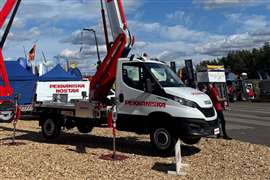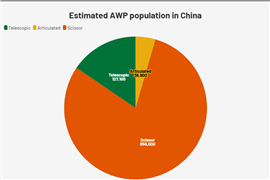Videos: Behind the scenes of Fehmarnbelt - the world’s longest immersed tube tunnel
30 October 2023
The Construction Briefing visits the €7.4 billion Fehmarnbelt project to see progress on preparations to build the world’s longest immersed tube tunnel.
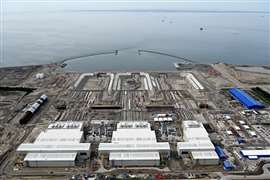 The tunnel factories, basins and work harbour, as viewed from above in August 2023 (Image: Femern A/S)
The tunnel factories, basins and work harbour, as viewed from above in August 2023 (Image: Femern A/S)
Born and bred on the island of Lolland in Denmark, Anders Wede remembers chasing rabbits across windswept fields growing up.
But the formerly sleepy port town of Rødbyhavn, from which ferries make the short crossing over the strait to the German island of Fehmarn, is now the biggest construction site in northern Europe.
It plays host to a factory operation, producing concrete segments for the world’s longest immersed tube tunnel (IMT), the €7.4 billion Fehmarnbelt project.
Then there’s the construction site of the tunnel portal itself, that will eventually serve as the starting point for cars and trains making their journey 18.2km under the sea from Denmark to Germany.
Local boy Wede now finds himself as construction area manager for Femern A/S – the company charged with building the tunnel with the assistance of two consortia of contractors (see below).
Currently, there are 2,000 workers employed at sites in Denmark and Germany, with even more employed at around 700 subcontractors throughout Denmark.
Some 1,200 workers, many from eastern Europe, live in a purpose-built temporary village in Rødbyhavn, complete with cinemas, gaming rooms, kitchens, a laundry and even a barber’s shop. A manager is in place to manage the practicalities of three shifts working on rotation.
The local area’s road network has had to be altered to accommodate construction traffic. The site even has its own hospital, staffed by a doctor and two nurses.
Construction involves connecting a total of 89 tunnel elements, each measuring 217 metres in length. Each standard element, weighing 73,500 tonnes, consists of nine individual segments that are joined together before being towed out to sea by tugboats and immersed into a 12m-deep trench on the sea floor.
Femern A/S has spent nearly three years preparing the site, constructing a specially built harbour capable of receiving up to 80,000 tonnes of material each week and the world’s largest tunnel factory where the tunnel sections will be made.
Fehmarnbelt: the technology behind the world’s longest immersed tube tunnel
The factory consists of three vast production halls, two with two production lines and one with a single production line. All three are now active and the first two tunnel segments have already been cast. They will produce 79 standard tunnel elements.
A separate outdoor casting area will see the production of a further 10 special tunnel elements. While a standard tunnel element will accommodate a two-lane motorway in each direction and two electrified railway tracks, the special elements will also have a basement floor for transporting equipment used in the tunnel’s operation and maintenance.
Construction progress
Construction work on the tunnel portal on the Denmark side is well underway, with the sea around it held back by a vast temporary dyke that means workers find themselves operating below sea level, with ships passing the harbour above them, further out in the strait.
Immersion of the first tunnel element, which will be connected to the portal, is set for late summer 2024. The tunnel trench, meanwhile, is 95% complete. The project also involves building a new substation and transformer to satisfy the power requirements of the trains and tunnel itself.
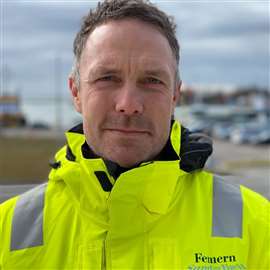 Anders Wede (Image courtesy of Femern A/S)
Anders Wede (Image courtesy of Femern A/S)
“I can’t really compare this with anything I have worked on before,” says Wede. “I have worked on some large projects but here we have spent the last three years building a production line capable of producing whatever is needed for our construction site.
“Our main construction site is actually out in the trench. So this is definitely a first – to be producing a production line on such a big scale, just to be capable of delivering material on our site,” he adds.
Getting those production lines up and running has been a “huge” challenge and Wede expects more to come. But he expresses surprise that one of the biggest challenges he expected – keeping the local community on board with such a massive project on their doorstep – hasn’t been as difficult as he thought.
“There has been a lot of challenges so far. But I would actually say that I expected more difficulties. I feared we would get a lot of complaints from locals. Of course, they have asked questions about noise, how long it will continue, and so on. But they have actually accepted our explanations and we allow them on site every third month to see what is going on,” he says.
“The locals hope that this link will bring a lot of good things to the area and everyone who is working on this project is quite excited. It is a huge scheme – nobody has ever done anything similar to this before.”
The factory operation
The three vast tunnel factory halls stand in an area that was once just fields, before work to build them started from scratch in 2021.
In addition to those halls is a ‘panel factory’ where steel required for the mammoth quantities of rebar the tunnel segments require (the equivalent to 50 Eiffel Towers in total) is prepared.
Delivered in coils, the steel is cut, straightened and welded in the factory with the help of state-of-the-art machinery and welding robots. The factory will handle 400 tonnes of steel on each of two production lines in the panel factory each week.
Once the rebar has been straightened, cut and bent into whatever configurations are required, it will be transported on trucks over to the tunnel segment production halls.
In the production halls themselves, the steel is built up into the shape required for an individual tunnel segment, weighing 430 tonnes for a standard element, in the assembly area. It is then pushed forwards on sleds and into the casting pit area.
In the casting area, the rebar is surrounded by formwork and prepared for the concrete pouring operation. Eight or nine concrete booms will be used for pouring in the concrete, at a rate of up to 200 cubic metres per hour.
To this end, the factory site is equipped with two huge concrete batching plants, capable of producing a total of 600 cubic metres per hour.
Each segment takes 30-36 hours to cast with no stops to prevent cold joints. Over the course of that process, 50-60 people are involved. Optimum conditions for casting the concrete for the normal elements inside the production halls is around 20 degrees Centigrade. Outside, for the special elements, 5-10C is preferred.
Each production line should cast a single segment once a week production is at full capacity, which means it will take nine to 10 weeks to produce a full tunnel element.
Once the concrete is cast, the segments are so heavy that they have to be pushed by hydraulic arms along concrete skidding beams coated with an epoxy layer to reduce friction.
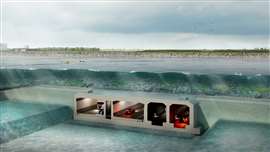 How the Fehmarnbelt will look in cross section (Image: Femern A/S)
How the Fehmarnbelt will look in cross section (Image: Femern A/S)
After casting, the end of each tunnel segment is mounted with a Gina gasket, which is a huge hollow vulcanised rubber fitting designed to sit around the entire end of the segment. The Gina gasket is then used to connect the segments forming a watertight seal.
To keep the tunnel elements rigid while being transported and to prevent damage to the membranes, the tunnel elements are fitted with steel bars running 270 metres along their length to stiffen them up. Once the tunnel elements have been immersed, placed and covered over in the trench, the contractors will cut the steel cables to allow the tunnel to be more flexible once again.
Workers will then add a second interior rubber membrane called the Omega, which is bolted to the elements from within. Together, the two rubber membranes ensure a watertight connection. According to Femern A/S they are very robust and rated to last much longer than the tunnel itself.
Basins
Once the elements are complete, they are pushed out of the tunnel factories and into the basins area.
The basins provide a link between the factory and the work harbour. Large gates ensure that the dry dock and basins can be filled with water and emptied as needed, allowing the elements (which despite their enormous mass, can float) to move from the factory to the work harbour and then further out into the Fehmarnbelt.
In September, Femern Link Contractors (FLC) switched on the pumps that will fill the three large basins (one per production hall) with water. Each basin is almost 11 metres deep and together they hold about 1.6 million cubic metres of water.
The floating segments will be manoeuvered with a system of cables towards the opening of the basins. Once pontoons have been attached, the tunnel elements will be filled with an additional 4,000 cubic metres of concrete so they will no longer float on their own, before being towed out to sea slowly by a tugboat prior to being immersed in the tunnel trench.
The first element to be immersed, currently under production in Hall B, will be element number 79. The numbered elements will count down from the Danish side to the German side.
The elements can be placed onto the seabed within a tolerance of 15mm thanks to a specialized GPS system, before being covered over once laid in the trench.
The process of connecting an element to a tugboat, transporting it out to sea, immersing it, and then returning for the next element will take four to six days. Weather is likely to have an effect on the process but the factory process has been designed to allow for 12 elements to be parked on the lines before production has to stop.
The tunnel portal
The tunnel portal and ramps (TPR) site on the Danish side sees the construction of the area where trains and vehicles will descend into the tunnel, on a 550-metre-wide area of reclaimed land.
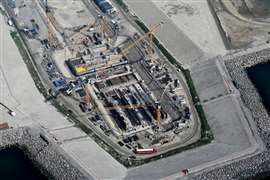 The tunnel portal in September 2023 (Image: Femern A/S)
The tunnel portal in September 2023 (Image: Femern A/S)
Work involves building a short section of cut-and-cover tunnel, about 160m in length, followed by another 100m of light attenuation structure (a safety feature featuring row of skylights that allows drivers’ eyes to adjust by giving a smooth transition between natural light outside the tunnel and the tunnel light fixtures).
Currently, contractors are focused on build a ‘sea cut off structure’ prior to the construction of a new interior permanent dyke along the new coastline. Once complete, the ‘bulge’ in the portal area will be flooded to a depth of 5-6m by removing the temporary dyke that sits around it.
Once that work is complete, the tip of the tunnel will be exposed on the seabed and will be ready for connection with the first tunnel element.
A few kilometres inland from the tunnel, contractors will build toll facilities although the designs have not yet been finalised because technology in that area is developing rapidly. Also under construction is a 217-metre-long look-out platform called “The Arrow” which Femern A/S hopes will become a landmark for the project.
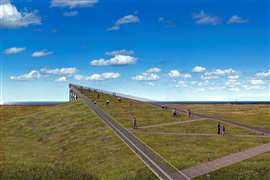 Digital render of how ‘The Arrow’ will look (Image courtesy of Femern A/S)
Digital render of how ‘The Arrow’ will look (Image courtesy of Femern A/S)
Completion and financing
The tunnel is expected to be completed in 2029, with a total cost of €7.4 billion (US$8.7 billion).
It will allow cars to take 10 minutes to drive from Denmark to Germany at speeds of 110km/h, compared to seven minutes by train at speeds of 200 km/h.
Femern A/S claims that it will shorten the travel time between Copenhagen and Hamburg by more than two hours to 2.5 hours in total.
Finance for the project has been provided via state-guaranteed loans, although ultimately, users will pay to use the tunnel to repay those loans. The repayment period is expected to be 28 years. The tunnel itself has a design life of over 100 years.
Project details
Client: Femern A/S, a specially-created subsidiary of Danish state-owned transport company Sund & Bælt.
Contractors: Fehmarn Belt Contractors (FBC), a joint venture between Boskalis and Van Oord has been conducting the main dredging and marine work. The Fehmarn Link Contractors (FLC) consortium, which includes Vinci, BAM, Per Aarsleff, Wayss & Freytag Ingenieurbau and Max Bögl Stiftung, has been constructing the tunnel, the portal buildings, the casting factory and workers accommodation since January 2021.
Tunnel size: The tunnel will have a 17.6km immersed section and will be 42 meters wide. Its foundation depths will reach more than 40 meters below sea level. It will comprise five tubes: two 2-lane motorways for cars; two electrified rail tunnels; and one emergency corridor.
Construction timing: Enabling works started on the project on the Danish side in 2020 and the German side in 2021. Dredging of the tunnel trench and construction of the factory began in 2021. The first tunnel segment is expected to be laid in late summer 2024 and the project is scheduled to complete in 2029.
STAY CONNECTED



Receive the information you need when you need it through our world-leading magazines, newsletters and daily briefings.
CONNECT WITH THE TEAM











